The lush green Anthurium with vibrant flowers adorning the living space is a dream of all plant lovers. But is that so hard to achieve?
Anthurium Salgarense is tropical vegetation that we are fortunate to be able to grow in our homes.
This rare plant variety is distinguished by its large, dark green, heart-shaped foliage. It is an evergreen plant that can flower for months if properly cared for.
Generally, Anthurium salgarense best grows in bright indirect light, temperatures between 65-75 degrees Fahrenheit with a moderate frequency of watering. Besides, it needs a humidity level above 65%, once 1-2 year reporting, and occasional pruning for healthy growth.

Anthurium salgarense grows extensively and develops glossy large leaves with increasing age.
It can be the absolute highlight of the house and extend the houseplant collection beautifully if you allow it to have a terrestrial habit.
If you want to read the complete care guide for Anthurium salgarense, continue this adventurous article!
Table of Contents Show
Plant Overview
Anthurium scherzerianum represents one of over 1,000 species in the genus Anthurium (the largest genus in the Araceae family) and Heinrich Wilhelm Schott is the man who first describe it in 1857.
These plants are available in Costa Rica, the Atlantic slope of Cordillera Central, and the Cordillera de Talamanca.
Also, they have heavily been distributed in the Tapanti and La Hondura areas. You can know more about Anthurium scherzerianum in the table below!
| Scientific Name | Anthurium Aff salgarense |
| Common Name | Flamingo Flower, Hawaiin Heart |
| Family | Araceae |
| Genus | Anthurium |
| Native | Endemic to Colombia |
| USDA Zones | 10 to 12 |
| Plant Type | Epiphytic plant |
| Growth Size | 8 feet |
| Foliage | Glossy giant leaves in heart shape |
| Flower | White or yellow spadix coated under Red spade |
| Toxicity | Toxic to both humans and animals |
Anthurium Salgarense Care
As Anthurium radicans require a similar environment to all other houseplants growing indoors or outside. So, it won’t be trouble for you if you know the right care requirements.
Anthurium salgarense prefers tropical dry forest habitat so, you can help it get the optimum condition by mimicking the tropical condition.
| Requirements | Optimum Conditions |
|---|---|
| Light | Bright indirect light |
| Water Requirement | 2 to 3 days or once a week depending on the season |
| Humidity | Above 65% |
| Temperature | 65 to 75 degrees Fahrenheit (18 to 24 degrees Celsius). |
| Growing medium | Well-draining soil with pH between 5.5 and 6.5 |
| Fertilizer | Bimonthly balanced fertilizer |
| Re-pot | Once 1-2 years |
| Pruning | Not often, occasional |
| Propagation method | Root division, seeds germination and stem cutting |
| Pests | Aphids, scales, mealybugs, and thrips |
| Diseases | Bacterial Blight, Bacterial Wilt, Rhizoctonia Root Rot, Phytophthora and Pythium and Black Nose Disease |
1. Indirect Bright Light
Anthurium salgarense is endemic to Colombia which includes Premontane wet forest and lower montane wet forest ranging from 900 to 1,800 meters in elevation.
Thus, it likes enough sunlight!
Anthurium salgarense needs bright indirect sunlight at least 10 hours a day.
However, this species can also tolerate low light but prefers bright sunlight to promote leaf development. In fact, they require a lot of energy to expand the lovely foliage.
Besides, Anthurium salgarense also prefers semi-shade so you can grow it under the tree outside.
However, during the colder months, you need to bring your Anthurium Salgarense inside and place them in a bright spot.
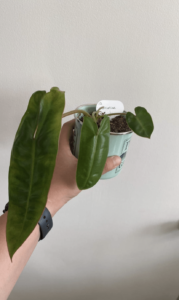
You can identify the following symptoms if you allow unfavorable lighting conditions.
| Symptoms of Light Deficiencies | Symptoms of High-Intensity Light |
|---|---|
| The leaves become thin and straggly. | The leaves begins to fade to a pale yellow hue. |
| The blooming time may deter. | The plant develops white and brown patches on the leaves. |
| The blooms can generally be pale green in color. | The plant releases more water via transpiration causing soil to compaction. |
| The plant can't absorb the moisture causing to root rot. | The plant also faces sun born to weaken stems. |
| The plant becomes susceptible to common anthurium bugs, pests, and diseases. | It causes dry and crispy foliage. |
| It can cause leggy and stunned growth. | The leaves and stem may curl and droop. |
If you want to grow this plant indoors, the bathroom, bedroom, study, and living room will be the best-suited place.
Tips to Provide Optimum Lighting Condition for Anthurium salgarense
- Place Anthurium salgarense in an open window with plenty of indirect sunlight, ideally, one facing south at the 4-6 feet distance.
- If not, you can take these plants to an east-facing window that receives sufficient light in the mornings.
- You can allow your plants to enjoy the companion with the window at a closer distance during winter when the sun is weaker.
- Also, rotate your plant to ensure that each part of the plant receives equal light throughout the year.
- You can use artificial lights, such as grow lights, in case you live in a dark apartment.
- If you feel your plant receives extensive light, you can cover it with light curtains or cloth.
- Rinse your plant’s leaves with a damp cloth once a week if the plant receives harsh light.
2. Moderate Watering
It is not tough to schedule water frequency, but it can be a little counterintuitive. Though Anthuriums belong to the tropical region, they can thrive in light water as well.
Anthurium salgarense needs low to medium amounts of water so you can provide watering every 2-3 days on the hot days or once a week during summer and spring.
Besides, if it is the winter period, you can provide once every two weeks for six weeks ensuring that the plants may not get root rot.

Pay close attention to symptoms of stress or thirst: thirsty plants will be light when lifted and will have saggy or dimpling leaves.
It is best to hydrate your plant using rainwater, distilled water, or boiled water that has been allowed to cool.
If the water requirement goes wrong, Anthurium salgarense can undergo several symptoms.
The leaves can appear limp and smushy, along with dark edges if the water receives overwater. Besides, overwater causes the plant to suffer from many fungal diseases and root rot.
However, if the plant does not possess enough water, it goes lacking nutrient supply and appears pale on its leaves.
Also, the plant droops and remains clumsy, ultimately continuing to stunning growth.
Tips to Provide the Proper Water to Anthurium Salgarense
- Water meticulously when the top 1-2 inches of soil becomes dry and stop watering when drainage holes leak.
- Maintain the soil dry out in between the watering.
- Put 1-2 inches of pebble stone in the bottom of the pot.
- Reduce the water amount if the plant has higher humidity.
- You can also invest in a moisture meter for accurate moisture reading.
Expert Tip: simply place five to six full-size ice cubes into the soil of your plants’ pots and allow them to dissolve if sun is harsh.
3. Warm Temperature
Anthuriums are temperature lovers due to their tropical habitat and grow best when offered a warm environment.
Anthurium Salgarense thrives at a temperature between 65 and 75 degrees Fahrenheit (18 to 24 degrees Celsius).
Being in the Anthurium group, they can also go for 78 to 90 degrees Fahrenheit but if they are above 90 F, foliar burning or faded flower color, and reduced flower life come as severe symptoms.
Also, acknowledge that Anthurium salgarense cannot withstand temperatures below 50 degrees Fahrenheit.
Night temperatures between 40 to 50 F thus, can result in slow growth and yellowing of lower leaves.

Anthurium salgarense also can’t tolerate frost and freezing conditions.
Tips to Maintain the Optimum Temperature Condition
- Bring your plant inside during the frosty cold night.
- Also, remove the plant from the window if it is kept there during the icy cold nights.
- Introduce grow lights to increase the temperature if needed.
- You can use frost blankets and a heating pad to protect the plant from cold.
- Keep your anthurium plant away from heat ducts, ventilator grills, and drafts.
4. High Humidity
Like tropical plants, Anthurium salgarense hates the dry air if offered around it. It requires a slightly higher level of humidity to appear in glossy leaves.
Anthurium salgarense grows best in moderately high humidity ranging from 40 to 70%.
As anthuriums dislike dealing with dryness around the root ball so they need adequate watering.
Thus, it is good to offer an environment with 65% or higher humidity levels for Anthurium salgarense.
If you happen to lower the humidity drastically, the plant will have new leaves flawed, and old leaves to roop.
Besides, low humidity can cause the tip to burn and root damage, drying the water in the soil.

However, if the humidity level crosses the optimum level, Anthurium salgarense will suffer from overwatering.
This can cause root damage, sudden yellowing of leaves, and invites infestation and multiple horticultural diseases.
Tips to Keep the Ideal Humidity for Anthurium salgarense
- You can use an artificial humidifier if your plant needs extra humidity.
- Alternatively, grouping the plants can be the humidifying method.
- If the humidity drops, misting the plant with 1-2 cups of water in the morning works best.
- Consider placing the plant in the bathroom or kitchen to increase humidity.
- Put 1-2 inches of pebble stone in the bottom of the pot to let the plant have extra moisture, avoiding overwatering effects.
Anthurium salgarense can tolerate higher humidity (over 80%) and respects lower moisture levels (40% RH).
5. Well-draining Soil
Anthurium salgarense is not an exclusion from the plant that needs special soil to grow. It can grow in normal gardening soils from sandy loams to clay with a well-draining facility.
Anthurium Salgarense prefers well-draining soil featuring pH ranging from 5.5 to 6.5.
It is to remember coarse and well-drained media matches a cactus, orchid, sand, or perlite soils that dry easily.

If you want your plant to grow in 100% sphagnum moss, keep it loosely packed in the planter.
DIY Potting Mix: Combine a peat moss base with a 1:1:1 ratio of peat moss, pine bark, and perlite.
Some Commercial Potting Mixes for Your Anthurium Salgarense
- Ocean Forest Potting Mix: Contains earthworm castings, bat guano, sea-going fish & crab meal, forest humus, moss
- Miracle-Gro Houseplant Potting Mix: Contains perlite, sphagnum, and peat moss
- Carnivorous Plant Soil Mix: Best for growing carnivorous plants
- Miracle-Go: Contains no compost or bark, which are known to shelter fungus gnats
- Wonder Soil Organic Potting Soil: Contains worm castings, mycorrhizae, kelp, perlite
6. Bi-Monthly Fertilization
Despite its lush appearance, Anthurium salgarense is not a heavy feeder. They need a diluted vitamin solution to help them recover from transportation shock.
Thus, Anthurium salgarense needs fertilizer twice a month during the growing period (spring and summer).
Consider the type of fertilizer, you can feed your plant with a balanced or all-purpose fertilizer.

It’s been quite some time since I have been providing my Anthurims with water-soluble fertilizers featuring NPK ratios of 9:3:6 and 12:12:12.
To encourage more flowers use a fertilizer higher in phosphorus during the growing season. If grown in a planting container, you can feed your vegetation at least three times a year using a slow-release feed.
Alternatively, liquid fertilizers are better absorbed and easy to apply for potted plants like your Anthurium. They are highly concentrated, so you must dilute them before use.
Organic fertilizers or homemade compost prepared by earthworms also work best for Anrheriums.
If you want to use ready-made or commercial fertilizers, we have some recommendations for Anthurium salgarense.
| Fertilizer | NPK Ratio |
|---|---|
| EZ-gro Blossom Booster | 10-30-20 |
| Down To Earth All Natural Fertilizers | 0-11-0 |
| Better-Gro Orchid Better Bloom | 11-35-15 |
| Burpee Bone Meal Fertilizer | 6-8-0 |
| Peter's Professional Fertilizer | 10-30-20 |
Tips to Fertilize Anthurium Salgarense
- Prepare a balanced fertilizer solution by mixing 1/2 teaspoon of fertilizer with 1 gallon of water if you use a balanced fertilizer.
- Water adequately before fertilizing the plant so that the soil can absorb it well.
- If you have a fertilizer with a ratio of 3:1:2, it is probably best to dilute to ¼ strength.
- Use bloom boosters if your plant is on the verge of flowering.
- Also, keep the plant parts out of contact with the drops of fertilizer.
- Strictly avoid fertilizing in the winter season as the plant goes to dormancy.
7. Annual Repotting
Planters or pots are key to hosting Anthurium salgarense for healthy growth as they serve as home to protect the nutrients for them.
Generally, Anthurium salgarense needs once every 1-2 years of repotting.
You may also read some signs to know if your plant needs repotting. The plant outgrows in the planter and needs more space to grow.
Leaves may curl and droop and the roots can come out of the drainage hole. Another sign will be that the plant develops bacterial blight or root rot.
Anthurium salgarense is a slow to medium-growing plant that needs more frequently than other dry lovers.
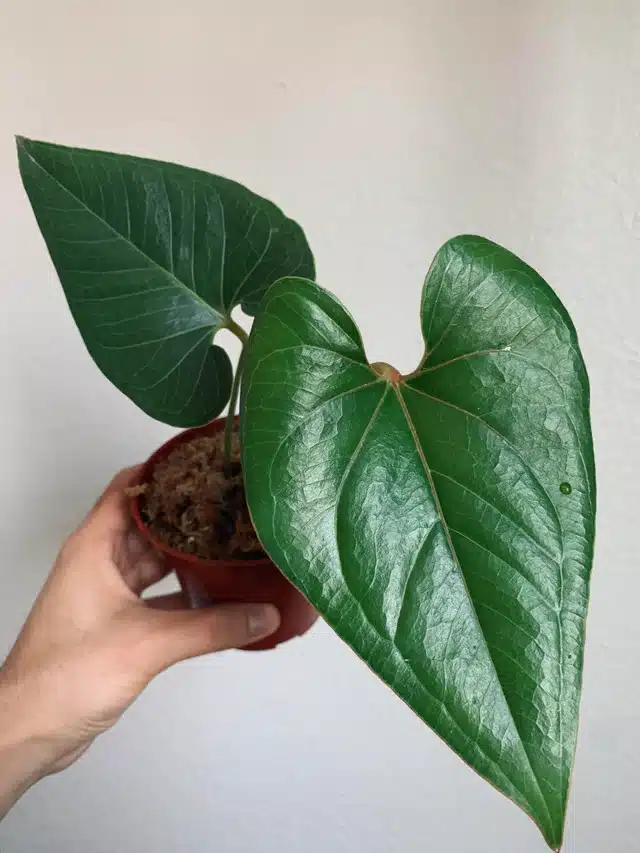
So you can use natural pots such as terracotta or clay pots to avoid root decay.
The baby Anthurium salgarense accepts pots of 2.5-5 cm size and 5- 8 inches pots can be the best fit for the adult ones.
Steps to Repot Anthurium Salgarense
- Fill the new planter with about a quarter of the potting medium and ensure it has bottom drainage holes.
- Detach the Anthurium from its existing pot delicately, trimming off the roots growing out of the drain holes if necessary.
- Trim roots if found extended without damaging the plant or the fragile root system.
- Position the Anthurium in the new pot and fill it with fresh potting soil, being careful not to plant it any deeper than it was previously.
Prepare a mixture of 3 parts orchid peat, 1 part leaf mold, and 1 part sphagnum moss to prepare well-draining soil for Anthurium Salgarense.
- Firm the soil around the plant’s base with your fingers and water thoroughly.
- Place the new planter pot where the plant was previously located.
- Water the plant on a regular basis and keep an eye on it.
8. Occasional Pruning
You need not bother to prune Anthuriums salgarense quite often. It may need pruning because the plant needs to shed dead or dying leaves and blooms so that it can receive good health.
If not trimmed for a long time, the plant seems bushy and shaggy. The pruning helps restore the vigor of blooming.
The bushy shape can cause stems to bend down leading to stunted growth. There can be many signs of a bacterial infection or other diseases if the plant keeps the weighty dead leaves and stems.
Thus, Anthurium salgarense needs pruning which is acceptable throughout the year whenever needed.
But these plants grow slowly indoors so you may not need pruning in such conditions.
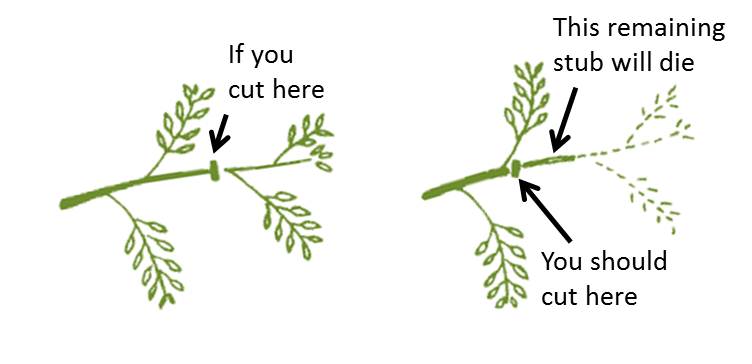
Things to Remember When Pruning Anthurium Salgarense
- Sterilize the cutting tools like shears to avoid infection
- Inspect the plants with discolored or dead leaves and start running from top-down.
- Cut the wilted and dead blossoms from top to down to the stem base.
- You can also cut off the wayward leaves to improve the plant, shape, and appearance but leave at least three to five in place.
- If you can find suckers, remove them from the base of the plant.
- After the pruning, wipe off all pruning tools so that you can use them next time as well.
Anthurium Salgarense: All About Growth Rate
Being an epiphytic plant, Anthurium salgarense is native to tropical dry forests, Premontane wet forests, and lower montane wet forests elevating at 900-1,800 m.
Anthurium salgarense presents to be a slow to medium-growing plant and grows up to 8 feet tall.
Like any other anthuriums, this plant can live up to 5 years or more.
Anthuriums are known to be shorter, ranging around 2′ to 3′ feet tall and 1′ to 2′ feet wide. But they are climbers and grow up 12′ to 15′ feet when their aerial roots receive adequate support.
Anthurium salgarenseis is known for its giant, shiny dark green, oblong, heart-shaped leaves. These leaves can be big between 16-28 inches.
Also, the plant’s stem lengths may extend to a height of 15-20 inches depending upon the size of the spathe.
They blossoms several times a year, and the flowers last for months, making them an excellent plant for newbies.

In appearance, Anthurium salgarense has showy flower bracts that come in shades of red spade with a protruding pale yellow, tail-like flower spadix.
The petals will last for about eight weeks on average. Bright light incentivizes these plants to prosper more. Nevertheless, the blooms are actually foul-smelling spathes.
Toxicity of Anthuriums Salgarense
Recently we have finished the pruning process so, you need to be careful when touching or bugging around Anthuriums Salgarense as it can poisonous.
According to ASPCA, Anthurium contains insoluble calcium oxalates which can be toxic to pets including cats, dogs, and horses.
These calcium crystals are released when these plants are bitten or chewed.
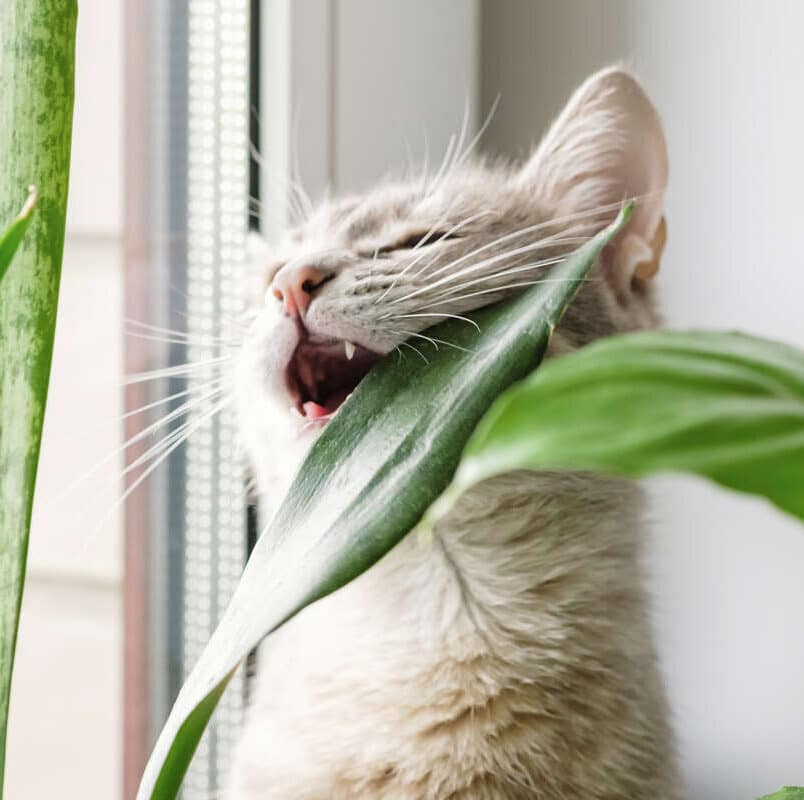
These crystals are poisonous causing tissue penetration and irritation of the mouth and gastrointestinal tissues.
These crystals may enter the airway and cause swelling in severe cases, making breathing difficult.
Salivating, anguish in the face and mouth, reduced appetite, and vomiting are all common symptoms.
These plants thrive in homes without curious cats and dogs, as well as young children who like to chew.
It is also worth mentioning that the sap can cause skin irritation and other allergic reactions.
So, you need to place Anthurium salgarense out of sight and reach of children and pets. If you feel any emergency for your pet, you can contact the following helplines.
Propagation Methods for Anthurium Salgarense
Anthurium salgarense is so pricey because they take a long time to mature into a pleasingly sized plant.
Bear this in mind if you wish to expand your treasure trove through propagation, as it may take several years for the divided plants to return to their “full looking” state.
1. Propagation Via Root Division
The good news is that you may need not perform extract effort for dividing Anthurium salgarense into reasonable sizes.
This helps the entire plant to grow healthily and promotes more flowering.
In fact, as long as each portion has a healthy root system, you can split your Anthurium into as many new plants as you want.
Steps to Continue Successful Propagation Via Root Division
- Inspect overcrowded pot and simply take the plant out of the pot in early spring.
- Now, separate some roots and look for the offshoots which are easy to take.

- Snip them apart with a sterilized knife or pruning shears and take care to maintain the fleshy roots and growth points.
- Expert Tip! You can divide roots in two or end up with ten new plants depending on the size of Anthurium salgarense.
- Remove these roots and replant them in a new pot using a healthy potting mix.
- Place in a shaded location and maintain a constant watering schedule.
2. Propagation Via Seeds
It is possible to grow Anthuriums from seed, but it is far from the best choice on this roster.
If you have an Anthurium that produces fruit, you can snip the fruit from the spadix and pull the seeds.
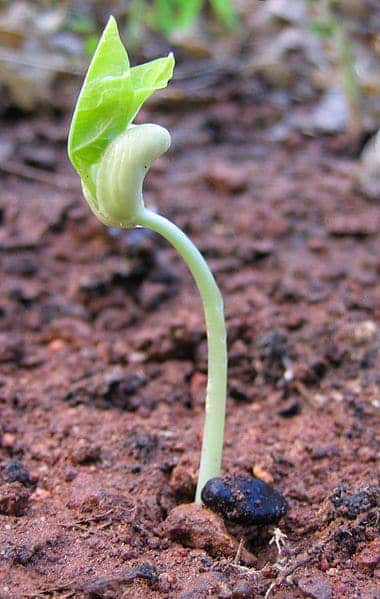
Propagating Anthurium salgarense from seed starts with tricking your plant into producing the plant seeds.
The flowers of this anthurium plant are the first female and change into males, which emit pollen.
Steps to Continue Successful Propagation Via Seeds
- Soak the seeds overnight before spreading them into the pot.
- Prepare seed bed with cocopeat and orchid bark.
- Lay the seeds on the potting medium without making them overpopulated.
- Lightly press the seeds into the vermiculite and leave them an inch (2.5 cm.) between.
- Now, cover the tray with plastic to increase humidity and water the seedlings regularly.
- Once you see about 3-4 leafs starting to appear after germination, you can plant them into a bigger pot.
3. Propagation Via Cuttings
Cuttings make it easy to multiply the anthuriums if you perform it with good attention. You need to consider if the stem pieces have includes at least two nodes.
You can make a baby Anthurium salgarense through this method in two different mediums!
Steps to Continue Successful Propagation in Soil
- To begin this, you need to cut off a stem from the plant and trim all the leaves near the stem.
- You can prune the stem into a number of pieces but each needs to have at least one leaf bud.
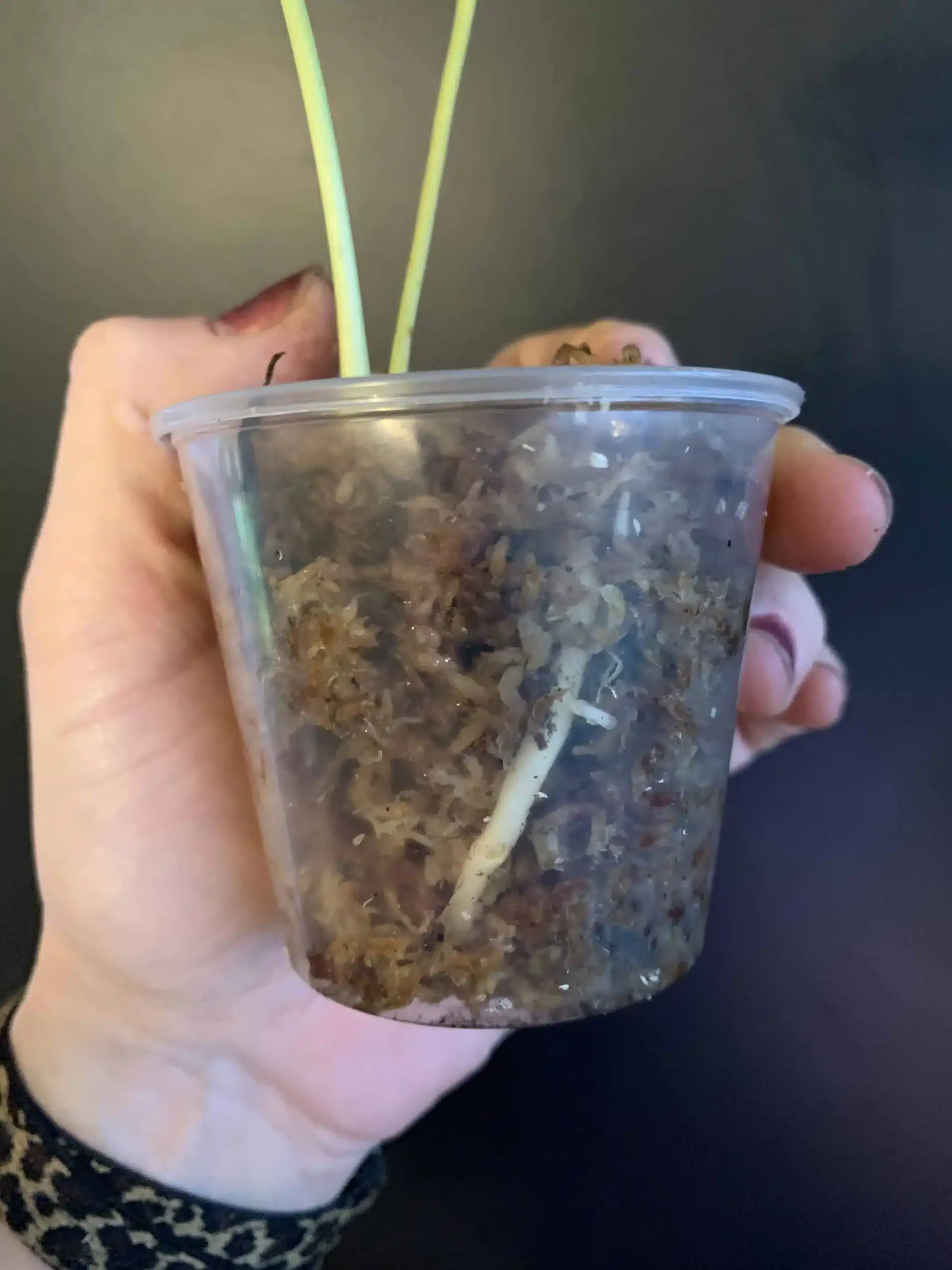
- Now, stick the pieces into an upright position in a vessel containing well-draining soil or a mixture of half sand and half pea.
- Keep the potting soil or DIY mixes somewhat moist and best at a temperature of 25 to 30 degrees C.
- The cuttings can develop roots and leaves shortly within a week.
- Once you notice that the small plants are enough in size to handle, you can transfer them into larger pots.
Steps to Continue Successful Propagation in Water
- Begin with the same as mentioned in the soil medium by cutting the stems.
- Take a transparent jar with water and dip the cuttings into it.
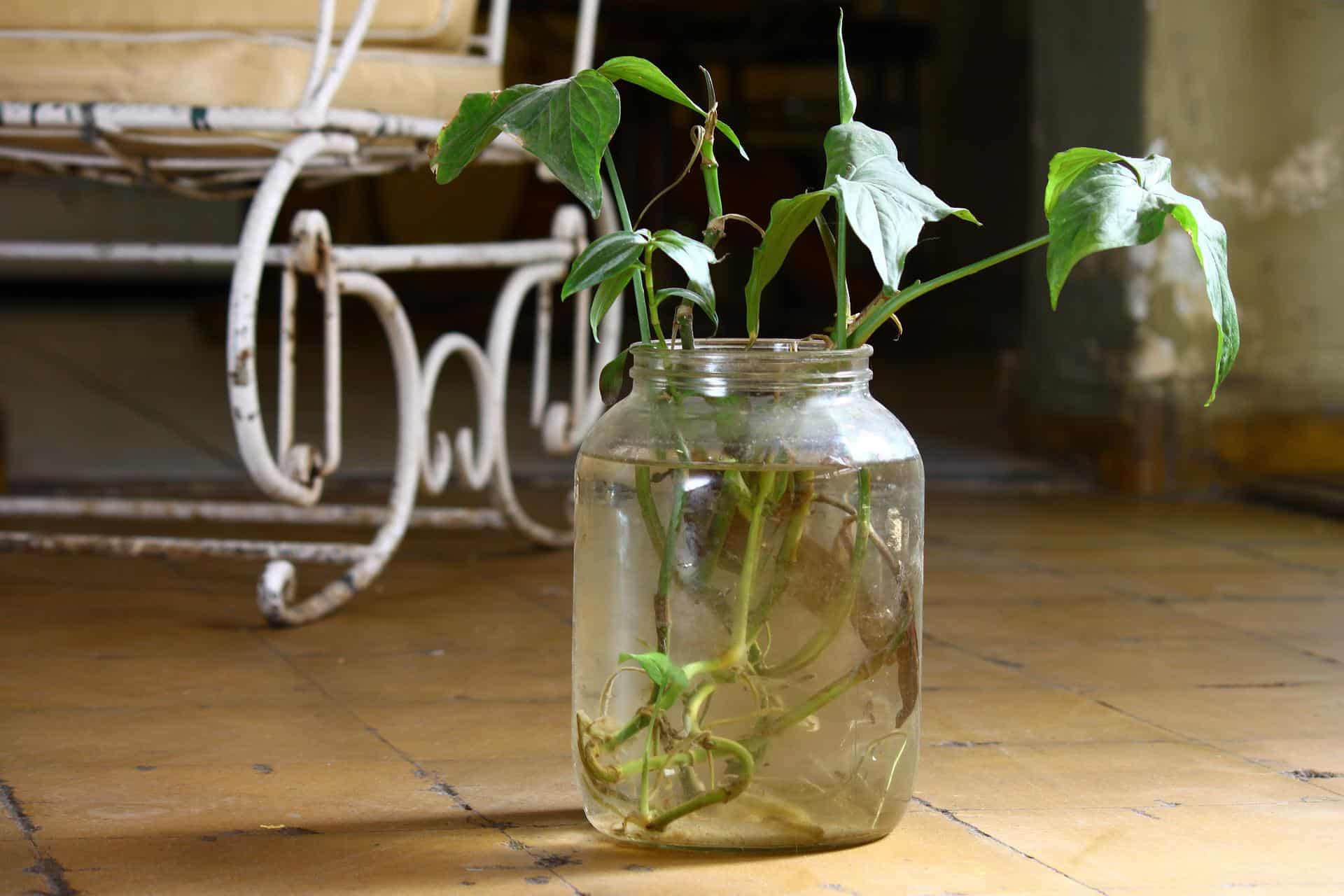
- The bottom of the cuttings needs to be submerged in water entirely.
- Also, make sure that the leaves are not flooded to avoid rot.
- Now you can place the cutting’s container in the bright place and wait for a few weeks to see roots growing in the jar.
- Once the cuttings are enough roots with good length, you can place them into the potting soil for a healthy plant.
Common Problems in Anthurium Salgarense
Are there any plants that come without any problems? The answer is no unless it is an artificial plant!
Here are a few problems, including pests and diseases your Anthurium salgarense might come across if you are a bit laid back on its care.
1. Common Pests
Anthurium salgarense is susceptible to the common pests that visit other indoor plants, including aphids, scales, mealybugs, and thrips.
They mostly feed on leaves and buds and attack the plant when it suffers unfavorable conditions such as low humidity.
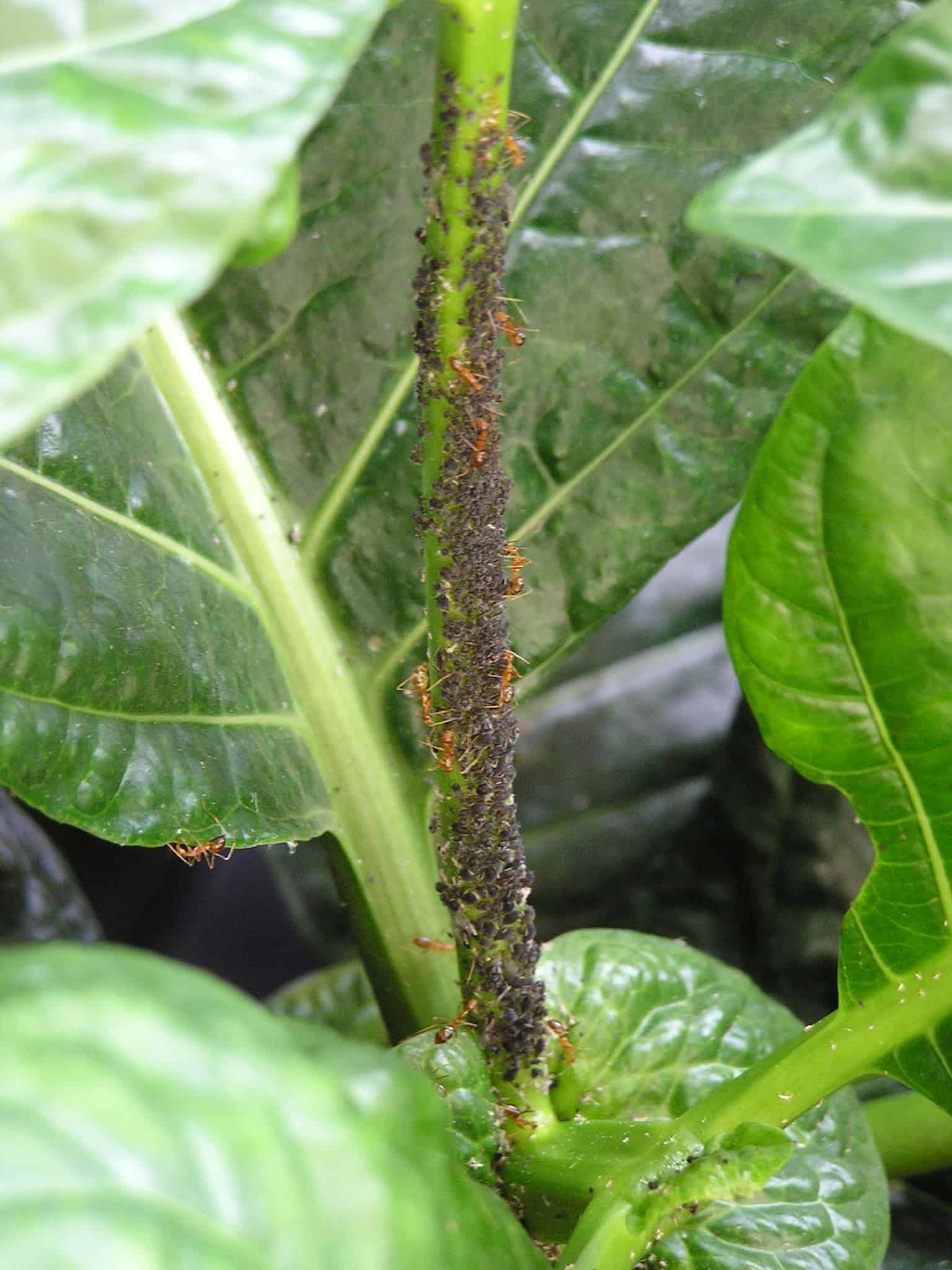
To continue inspecting the pests, follow the table!
| Common Pests | Signs |
|---|---|
| Mealy Bugs | These tiny waxy bugs contain white-cotton like substance. They occur on the undersides of the leaves. |
| Spider Mites | These pests are yellow halo like structure on the leaves. When they attack, leaves appear speckled and wilts, limps, and droops. |
| Thrips | Yellow speckled and silvered pests on leaves. The leaves appear black due to thrips. |
| Scales | Shell-like bumps on plant stems and the underside of leaves Thrive in warm, dry environments |
| Aphids | Tiny, pear-shaped pests in a variety of colors, which live undersides of the leaves Prefer wet conditions |
Treatment Measures
- First, start by splashing on the entire plant but make sure you will take care of the potential damage to the plant.
- The best method of insect control is to monitor your anthurium plants and treat them before they get out of hand.
- There are some “insecticidal soaps” which work well on soft insects, but scales may need a stronger insecticide.
- Cut the dead or diseased leave, stems, and flowers.
- You can take a cotton ball and dip it into isopropyl alcohol and end up applying it to the infected parts.
- Alternatively, horticultural oil can also be helpful to repel pests.
Preventive Measures
- Avoid grouping your plant collection along with Anthurium salgarense.
- Use commercial pest-free potting mix.
- Schedule once a week to wipe off the plant with soap.
- You can also consider pruning the infected parts of the plant regularly.
2. Horticultural Diseases
Anthurium salgarense can also be prone to multiple horticultural diseases that may develop yellowing and browning leaves.

Besides, discoloration of leaves and root rot are the usual unfavorable condition for this plant. You can inspect if your plant has any disease through the table below!
| Diseases | Causal Agents | Symptoms |
|---|---|---|
| Bacterial Blight | Xanthomonas oryzae | Small water soaked marks on leaves |
| Bacterial Wilt | Ralstonia solanacearum | Yellowing (chlorosis) leaves |
| Rhizoctonia Root Rot | Rhizoctonia solani | Young, tender stems to get girdled, and become water soaked, Cause stems to be unable to support the weight of the plant |
| Phytophthora and Pythium | Phytophthora nicotianae var. parasitica and Pythium splendens | Attack root systems Causes plant to wilt even though adequate soil moisture |
| Black Nose Disease | Colletotrichum gloeosporioides | Causes havoc in cut-flower and potted-plant production |
Treatment Measures
- Remove all disease or infected parts immediately with sterilized shears.
- Stop watering your anthurium plant if it has developed root rot.
- You can apply the solution of synthetic fungicides on leaves.
- Alternatively, using a soap water will be also beneficial.
- Transfer the plant to a new planter.
Preventive Measures
- To avoid the infection or further bacterial symptoms, you can schedule wiping off the leaves every two weeks.
- Quarantine the infected anthurium to avoid spreading the disease.
- Apply fungicide to your anthurium plant every two years.
- If the plant preserves excess moisture, avoid watering until the soil gets dry.
- Misting leaves at night so avoid it.
Conclusion
Anthuriums Salgarense is among the best indoor plants to own due to its low maintenance, ability to spark conversation, and air purifying abilities.
Proper care of these plants in your home can result in stunning, long-lasting flowers that you will cherish for a very long time.
I have explained everything in detail and hope you follow these to grow your anthurium plant to a fuller size.
If you have other varieties of anthurium such as Anthurium Macrolobium, Anthurium Moodeanum, and Anthurium Coriaceum, continue bugging here!
Happy gardening!
